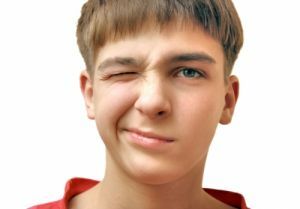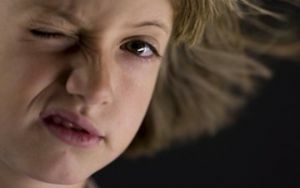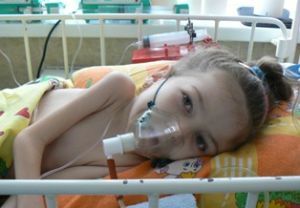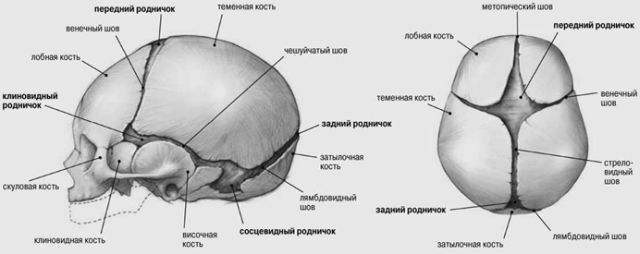 Initially, the manifestations of Tourette's syndrome were regarded in society as a result of bad education( or complete absence of it) in the families of the high-born: the child is spoiled, everything is allowed to him.
Initially, the manifestations of Tourette's syndrome were regarded in society as a result of bad education( or complete absence of it) in the families of the high-born: the child is spoiled, everything is allowed to him.
Either as a result of low mental development, when it comes to the children of beggars( as they say: oats - from oats, and dog - from the dog).
And how else could you regard the behavior of a far smaller child who suddenly started out like a parrot echoing other people's words and performing strange( often perceived as obscene) movements? Parents densely reddened, and on departure of guests they took hold of the belt.
And any attempts by the child to explain that at that moment he simply could not help grinding or "shaking manes" caused even more waves of parents' anger: are you even kidding? !And very often a selective parental battle was added desperate phrase: you again - for your own? !
For this case of "mocking" behavior of the child was far from the first: last time the father "by his grace" lost his job. And before that, my mother was nearly beaten in the market when my son "broke" and he began to loudly click his tongue and make smacking and sucking movements, looking at the seller of cheap fish during a gambling with his mother.

The person of noble origin( the level and age of Chevalier d'Artagnan) and for the lesser "evil" than the wink, or the folding of the lips with a tube, or "bodanie" head, relied on death in a duel, for even the only misinterpreted movement of the eyebrow at that timealready considered an insult!
So it was. For the study of the disease in those remote times, when everything strange and inexplicable could be reduced to demon possession( the first description of the symptoms was made in 1489 in the "Hammer of Witches"), was just beginning.
And the first observation was exactly the family, inherited along with the name and social status, the continuation of the ailment in children( especially in boys).
Contents
- In the name of Georges Gilles de la Tourette
- Enchanted legacy: causes and biochemistry of the disease
- Stages of development and severity of the
- syndrome The first signs: "Forgive me, Mom, I am this!"
- Tourette symptoms: "spasm of words and deeds"
- Differential diagnosis: ticks and "peaks"
- Reset chains, discharge the clip
- Complications and consequences: variants possible
- Prevention: with understanding and care
In the name of Georges Gilles de la Tourette
Modern Scientistshas the right to be indignant: how, described only 9 cases with similar symptoms - and your name is already called the disease? !And  where is monitoring and ten-year scrupulous research? !
where is monitoring and ten-year scrupulous research? !
But there was a year 1885 in the courtyard, the description was unexpected and brilliant, and the main thing was that the beloved disciple of Jean Martin Sharko did not just notice what was not seen by other doctors - he reduced the disparate facts to the system and created the psychiatric concept of the disease!
From here and honor - the state began to be called: Syndrome or Tourette's disease( more fully: Gilles de la Tourette's disease), or a disease of convulsive tics, or ticoid hyperkinesis, or generalized tic.
All synonyms reflect the main feature of the ailment - its debut( repeating then of the same type or having different character) tics.
It is now, after examining the tissue of the brain( the shell, the temporal, frontal and occipital lobes) posthumously and establishing a low AMP,
content in it or using magnetic resonance imaging( or positron emission), EEG and other methods of brain examination( in vivo andbloodless) - looking into the depths of its subcortical structures - it is possible:
- to establish the insufficiency of the saturation level of the brain with magnesium and lithium;
- to reveal the hypersensitivity of postsynaptic receptors to dopamine;
- to determine the level of deficiency of the enzyme, "disconnecting" a short-circuited system of synapses.
And on the basis of this, draw a conclusion about the violations in the extrapyramidal system that lead to the appearance of motor and vocal tics - a kind of violent movements-seizures that determine the strange and unjustified behavior of those suffering from Tourette's syndrome.
In the days of Gilles de la Tourette, the idea of an independently existing disease could only be met with close attention to the classic combination of symptoms that emerged for the first time in adolescence:
- , forced actions and poses, born as a result of muscle contractions( twitchings)management of patients;
- strange( obviously violent nature) cries ;
- echoing its or other people's words( or syllables) - echolalia, Palalalia ;
- is an irresistible need to cry out and spew out the foul language of in public( "verbal diarrhea," or coprolathia), which later has a wavy course and a propensity for progression( with the risk of remaining for life).
Enchanted Legacy: Causes and Biochemistry of
Disease Numerous studies have proven: 
- is a hereditary condition;
- proceeds through an autosomal dominant( less often autosomal recessive) "scenario", which creates the prerequisites for the structural and functional immaturity( congenital defect) of the basal ganglia of the brain.
To the manifestation of the same pathology( and its fixation in the body and psyche) during pregnancy contribute:
- reception of cocaine;
- the use of anabolic steroid drugs;
- state of hyperthermia;
- transferred streptococcal infection.
But changes in the state of basal ganglia can be achieved with the help of:
- biochemical effects( on the exchange of dopamine, serotonin, GABA);
- of neurosurgical intervention( thalomotomy, leukotomy);
- of their extreme "extinction" or electrical stimulation,
And this is not the "last ace in the sleeve" of medicine, so there is hope of healing!
Stages of development and severity of the syndrome
The frequency of repetition of ticks( per minute) can be:
- from 1 time per 2 minutes( at stage I of the disease,
- to 2-4 at stage II,
- increasing to 5 and above in stage III;
- and becoming even more frequent in stage IV.
The criterion of severity of the disease( syndrome) of Tourette is the degree of the patient's control of its manifestations:
- At the first( light) degree, the symptoms of the outward appearance almost do not manifest( for a short time, even completely
 absent)
absent) - The second( moderately expressed) degree is manifested by hyperkinesis and vocal disorders that are evident to the outside environment, as well as the absence of an asymptomatic period. The patient, feeling the premonition of a tick, may become inattentiveor hyperactive, but there are no barriers to stay in society.
- With the third( pronounced) degree, control over the obvious manifestations of the disease becomes problematic for the patient - it is short-lived and ineffective, the patient becomes a recluse avoiding society.
- The fourth( severe) degree of : the symptoms of the disease are expressed extremely sharply and practically can not be controlled by patients.
First signs: "Forgive me, Mom, I am this!"
The first unobtrusive "dislocations" of behavior in Tourette's syndrome can appear as early as 2.5 years. Parents are still not very worried about the child's hyperkinesis - committed in excess of a seemingly violent, involuntary movement, lacking the sense of both biological and physiological.
And, calmed by the father: "nothing will outgrow" or "let it develop," the mother of the child postpones the visit to the doctor.
But with the development of speech to the "awkwardness" of the body( echopraxia - copying of other people's actions), repeated repetition of words( palalalia - words of one's own or echolalia - someone else's) are attached.
Together with the desire for independence from parents( and from someone else's opinion in general) develops coprolathy( seemingly demonstrative foul language) and coproprxia( repetition of vulgar gestures and gestures), as well as involuntary spitting( bird fever).
In the case of coprolalia, remission episodes are especially rare and short-lived, and, as the "treatment" of the belt only aggravates, parents begin to understand: there is something wrong here.
Tourette-symptoms: "spasm of words and deeds"
 Despite the wavy flow of the flow - alternation of exacerbations( lasting several months and years) and remissions - the disease tends to progressively progress.
Despite the wavy flow of the flow - alternation of exacerbations( lasting several months and years) and remissions - the disease tends to progressively progress.
Its feature is an irresistible, painful desire to "splash out" with a word or action that brings the patient unspeakable relief( "as if a dam collapsed inside" or "the mountain fell off his shoulders").
Relief is short-lived, but it is vital for the patient, who has to restrain a whole "volcano" of various passions and stresses, and he periodically "releases steam" so that this "volcano" does not explode, and does this without interrupting his usual life activity.
Although Tourette's syndrome does not affect the mental faculties, but the "spasm of words and deeds" makes the environment of the "victim" very confused, and he has to struggle with all his strength. But the more restrained emotionally trying to be a patient, the more often he "breaks through".
The initial manifestation of the syndrome is motor tics, which( like the invisible roots of the tree), beginning to "grow" from the head and quickly "braiding" it, gradually grab the neck and limbs.
Simple tics are the least durable and involve one muscle group in the process, complex ones - develop in several muscle groups.
The appearance of motor tics is unpredictable in time, they are not only meaningless externally and are capable of causing inconvenience, but can also be very painful. Tics can be manifested:
- clatter teeth;
- by pressing on the eyes;
- biting lips;
- blows head on objects;
- bouncing;
- clapping your hands;
- by involuntary touching yourself, surrounding people, objects;
- grimaces, obscene gestures.
After repeating the required number of times, the tick stops.
In the tics, the motor is then organically "intertwined" with the ticks vocal, with the passage of time incredibly complicating simple at first symptoms. 
Vocal ticks arise among ordinary speech, have the character of reproduction of strange sounds and noises( coughing, barking, hissing), individual syllables inserted at the beginning of the word or sentence, remind stammering or other speech defects.
It can also be a pass in the conversation of basic information, without which the meaning of the phrase can not be understood, or emphasis on any secondary word or direction of thought.
Like motor tics, vocal are divided into simple( sound or noise) and complex( "juggling" words and syllables).
To the same type of ticks, echolalia and palylalia are included. Particularly striking interlocutor coprolalia - the moments when the deliberately loud use( shouting) of abusive words and expressions having a sexual orientation, neither to the person with whom the conversation takes place, nor to the situation discussed with him does not apply.
Other signs of Tourette's disease include behavioral disorders in the form of:
- obsessive-compulsive syndrome( with compulsive behavior caused by obsessive thoughts);
- attention deficit disorder;
- impulsiveness( aggressiveness), emotional lability.
A video film about how to be sick with Tourette's syndrome in real life:
Differential diagnosis: tics and "peaks"
The following are considered diagnostic( including differential-diagnostic) criteria in the world practice:
- manifestation of the "peak" of the disease before the age of 20;
- complex movements of rapid, repeated( with an involuntary and non-purposeful nature) involving large muscle groups;
- mandatory presence of vocal ticks( one or more number);
- wavy flow( with a clear exaggeration and remission, with a change in the intensity of the symptoms for a short period of time);
- invariability of maintenance of symptoms within a certain period( more than 1 year).
Unlike other similar clinic-related diseases, the tics of Tourette's syndrome differ: 
- monotony;
- speed;
- is irregular;
- the possibility of being suppressed for an exceptionally short period of time;
- occurrence before the beginning of a tick of prodromal urge - a strong dominant( similar in intensity with intolerable skin itching), a sharp voltage that can be resolved, only allowing the tick to be.
Differentiate Tourette's syndrome from the following pathology:
- of Wilson-Konovalov's disease;
- of the juvenile form of Huntington's disease;
- of the juvenile form of Parkinson's disease;
- torsion dystonia;
- is a dopamine-sensitive torsion dystonia.
In cases when it is necessary to exclude a different pathology of the nervous system, tomography( both MRI and computer), dopplerography of the vessels of the head and neck, as well as EEG and biochemical studies of biological fluids are used for diagnosis.
Reset chains, discharge the clip
Treatment of Tourette's syndrome is a delicate matter. After all, despite the external "activity", the children suffering from it are clamped in the grip of numerous bans imposed on themselves.
 Their life is so constrained by the "cement" of shame, debt, conscience that only "tics" that "explode" it from inside can make cracks in it, through which for a short time their small but obligatory "I" can break out.
Their life is so constrained by the "cement" of shame, debt, conscience that only "tics" that "explode" it from inside can make cracks in it, through which for a short time their small but obligatory "I" can break out.
Therefore, the object of treatment here can not be only the body - its goal, first of all, should be a delicate and delicate re-adjustment of the entire way of life, thoughts and feelings of the child. This work is similar to unwinding an invisible chain, into which he himself tightened himself tight.
The chain, to which the psyche of a child suffering from Tourette's syndrome is braided to a state of almost complete immobility, moral and emotional.
In this - the main difficulty of working with these children. And here there is no way to do without bringing up the parents of the child, who are themselves full of different similar complexes, although for them the age of crisis seems to have already passed. Only in close cooperation with parents the child psychiatrist is able to return the child to a full life in the body, family and society.
Specifically, this means the use of:
- psychotherapy;
- autogenous training;
- hypnotherapy;
- cognitive-behavioral therapy using the feedback method conducted in specialized rehabilitation centers.
And "discharge the cage" of impulses to motor and vocal ticks, which "twists" the body into a "rope", in especially difficult cases, the drug is medicated - individually selected combinations of antipsychotics, antidepressants, antihypertensives and dopamine receptor blockers( in adequate doses).
The combination of Haloperidol and Clonidine is considered to be the most effective, but also quite sparing at present.
But the last word in the treatment of Tourette syndrome by doctors and scientists has not yet been said.
Complications and consequences: variants of
are possible. By the middle of the adolescent period of life( from 12 to 14 years), the syndrome reaches its peak, and 90% of those suffering from it are on the decline, by the age of 20 almost completely coming to naught.
But in the remaining 10% progress continues, and in adulthood can lead even to disability with total disability.
Since the complete healing of the ailment is currently impossible, adults( no longer with the syndrome, but with Tourette's disease) can be panicked, depressed, or manifest themselves as antisocial behavior.
Prevention: with understanding and care
 Despite the scientifically proven hereditary nature of the disease, the mapping of the gene( s) responsible for the development of this pathology has not taken place until today.
Despite the scientifically proven hereditary nature of the disease, the mapping of the gene( s) responsible for the development of this pathology has not taken place until today.
Therefore, emphasis should be placed on the education of healthy communication skills in the family and society - to preserve the mental health of the nation.
Social adaptation of patients with Tourette's syndrome is not only necessary, but it is also possible with proper formulation of the question and its competent resolution.
The education of social tolerance for "not like everyone else" should become one of the most important tasks of human society. And then neither war nor duel will be needed anymore!



